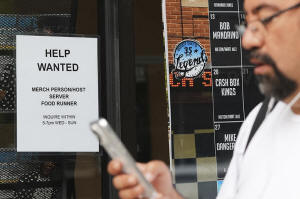Economy likely created 115,000 jobs in July as labor market loses
momentum
[August 01, 2025] By
PAUL WISEMAN
WASHINGTON (AP) — The American job market is deteriorating -- ever so
slowly.
It’s not showing up as widespread layoffs. The unemployment rate is
still low.
It’s subtler than that: New college graduates are struggling to break
into the job market. The unemployment rate for college graduates 22 to
27 years old, reached 5.8% in March, the highest, excluding the
pandemic, since 2012, and far above the nationwide unemployment rate.
Many Americans are staying in their jobs, unwilling to start the job
hunt, because they believe this is as good as it gets, and there is
growing evidence that they're right: Few industries are actually hiring
aggressively.
The current situation is a sharp reversal from the hiring boom of just
three years ago when desperate employers were handing out signing
bonuses and introducing perks such as Fridays off, fertility benefits
and even pet insurance to recruit and keep workers.
When the Labor Department puts out its July employment report Friday,
it’s expected to show that companies, government agencies and nonprofits
collectively added 115,000 jobs last month, according to a survey of
forecasters by the data firm FactSet.
That is not a bad number but its worse than last year, and even last
month, when employers added 147,000 jobs. So far this year, employers
have added an average 130,000 jobs a month, down 23% from last year's
hiring and a whopping 68% below the 2021-2023 average when the economy
was bounding back from COVID-19 lockdowns.
Weighing on the job market are the lingering effects of higher interest
rates that were used by the Federal Reserve to fight inflation;
President Donald Trump’s massive import taxes and the costs and
uncertainty they are imposing on businesses; and an anticipated drop in
foreign workers as the president’s massive deportation plans move
forward.
“The labor market is poised for a summer slowdown as businesses put
hiring plans on hold but refrain from broad-based layoffs,” Gregory Daco,
chief economist at EY-Parthenon wrote in a commentary this week. “We see
job growth slowing well below trend in the coming months.’’
Still, most American workers enjoy an unusual level of job security. The
unemployment rate is low at 4.1%. The number of Americans applying for
unemployment benefits — a proxy for layoffs — remains at healthy levels.
But Adam Schickling, senior economist at Vanguard, cautions that “a low
unemployment rate and a muted pace of layoffs mask underlying
weakness.’’
[to top of second column] |

Help wanted sign is displayed at a live music and blues club in
Chicago, Thursday, July 24, 2025. (AP Photo/Nam Y. Huh)
In a commentary Tuesday, Schickling
wrote that the health of the job market “can be a matter of
individual perspective...If you’re a registered nurse, you may
believe the job market’s health to be excellent. The unemployment
rate for experienced health care practitioners is currently below
2%. If you’re young and just entering the labor force or you’re
older and seeking to reenter it, prospects may seem bleak.’’
The rate of people quitting their jobs — a sign they’re confident
they can land something better — has fallen from the record heights
of 2021 and 2022 and is now below where it stood before the
pandemic.
For one thing, hiring has become concentrated in a handful of
industries. So far this year, for example, private U.S. employers
have added 644,000 jobs. Of those, nearly 405,000 — or 63% — were in
just one of the Labor Department’s industry categories: healthcare
and social assistance, which spans everything from hospitals to
daycare centers.
As hiring has cooled over the past couple of years it’s become
harder for young people or those re-entering the workforce to find
jobs, leading to longer job searches or spells of unemployment. The
Labor Department said the number of discouraged workers, who believe
no jobs are available for them, rose by 256,000 in June to 637,000.
“Historically, a decline in hiring has been accompanied by a swift
rise in layoffs, a one-two punch that drives up the unemployment
rate,” Schickling wrote in a commentary. “Today’s labor market is
defying that pattern.’’
One reason is that manufacturing companies, which tend to pull the
trigger on layoffs quickly when economic conditions weaken, account
for an ever-smaller share of American jobs. “So there is simply less
headcount to cut,’’ he said.
The bottom line: “Firms are pulling back on hiring without shedding
existing workers in significant numbers,’’ Schickling said. “The
result is a labor market that is softening gradually, not
collapsing.’’
All contents © copyright 2025 Associated Press. All rights reserved |